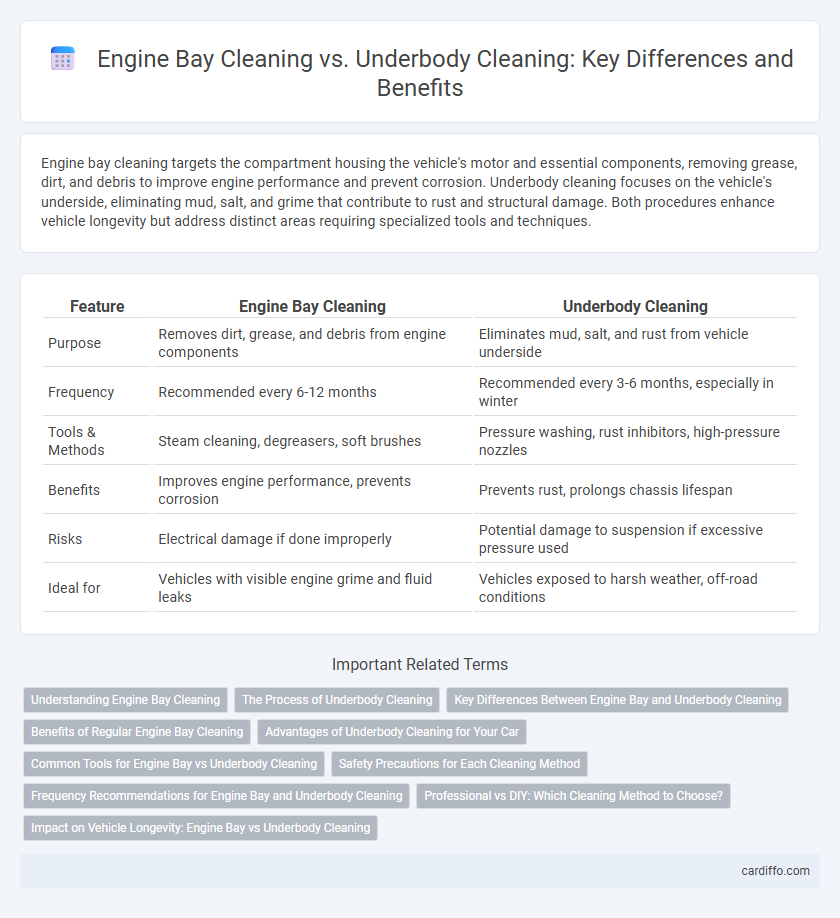Engine bay cleaning targets the compartment housing the vehicle's motor and essential components, removing grease, dirt, and debris to improve engine performance and prevent corrosion. Underbody cleaning focuses on the vehicle's underside, eliminating mud, salt, and grime that contribute to rust and structural damage. Both procedures enhance vehicle longevity but address distinct areas requiring specialized tools and techniques.
Table of Comparison
| Feature | Engine Bay Cleaning | Underbody Cleaning |
|---|---|---|
| Purpose | Removes dirt, grease, and debris from engine components | Eliminates mud, salt, and rust from vehicle underside |
| Frequency | Recommended every 6-12 months | Recommended every 3-6 months, especially in winter |
| Tools & Methods | Steam cleaning, degreasers, soft brushes | Pressure washing, rust inhibitors, high-pressure nozzles |
| Benefits | Improves engine performance, prevents corrosion | Prevents rust, prolongs chassis lifespan |
| Risks | Electrical damage if done improperly | Potential damage to suspension if excessive pressure used |
| Ideal for | Vehicles with visible engine grime and fluid leaks | Vehicles exposed to harsh weather, off-road conditions |
Understanding Engine Bay Cleaning
Engine bay cleaning removes grease, dirt, and debris from the engine compartment to improve performance and prevent corrosion, using specialized degreasers and low-pressure water tools. Proper cleaning helps maintain critical components, such as sensors and belts, ensuring optimal engine function and extending vehicle lifespan. Unlike underbody cleaning, which targets the chassis and suspension to reduce rust and buildup caused by road salt and grime, engine bay cleaning focuses specifically on safeguarding the engine's mechanical and electrical parts.
The Process of Underbody Cleaning
Underbody cleaning involves using high-pressure water jets and specialized brushes to remove dirt, salt, and grime from the vehicle's frame, suspension, and exhaust components. This process often includes applying rust-preventive treatments and thorough rinsing to ensure corrosion resistance and enhanced vehicle longevity. Compared to engine bay cleaning, underbody cleaning targets hard-to-reach areas prone to damage from road debris and environmental contaminants.
Key Differences Between Engine Bay and Underbody Cleaning
Engine bay cleaning targets the area housing the engine and its components, emphasizing the removal of grease, oil, and dirt buildup to improve performance and prevent corrosion. Underbody cleaning focuses on the vehicle's underside, addressing accumulated mud, salt, and road grime to protect against rust and structural damage. The key differences lie in their specific areas of attention, cleaning methods, and the types of contaminants each process aims to remove.
Benefits of Regular Engine Bay Cleaning
Regular engine bay cleaning prevents dirt, grease, and debris buildup that can cause overheating and mechanical issues, enhancing the engine's performance and longevity. It also helps identify leaks, worn components, and potential problems early, ensuring timely repairs and reducing costly breakdowns. Maintaining a clean engine bay improves vehicle aesthetics and resale value by presenting a well-cared-for engine compartment.
Advantages of Underbody Cleaning for Your Car
Underbody cleaning effectively removes dirt, salt, and corrosive debris that accumulate beneath the car, preventing rust and extending the vehicle's lifespan. This process improves overall vehicle safety by maintaining the integrity of critical components such as the suspension, exhaust system, and brake lines. Regular underbody cleaning also enhances fuel efficiency by reducing drag caused by accumulated grime and debris.
Common Tools for Engine Bay vs Underbody Cleaning
Engine bay cleaning commonly requires tools such as soft brushes, degreasers, plastic covers, and compressed air to safely remove grime without damaging electrical components. Underbody cleaning typically involves high-pressure washers, undercarriage brushes, rust inhibitors, and drain pans to effectively eliminate dirt, salt, and road debris. Choosing the right tools ensures thorough cleaning while protecting sensitive parts of the vehicle.
Safety Precautions for Each Cleaning Method
Engine bay cleaning requires disconnecting the battery and covering sensitive electronic components with plastic to prevent water damage, while using non-corrosive cleaners to avoid degrading delicate parts. Underbody cleaning demands raising the vehicle securely on a lift or ramps and wearing protective gear to shield against debris and high-pressure water spray. Both methods benefit from using environmentally safe detergents and thorough drying to prevent rust and electrical faults.
Frequency Recommendations for Engine Bay and Underbody Cleaning
Engine bay cleaning is recommended every 6 to 12 months to prevent buildup of grease, dirt, and debris that can impact performance and cause corrosion. Underbody cleaning should be performed more frequently, ideally every 3 to 6 months, especially in regions with heavy road salt or mud exposure to protect against rust and structural damage. Regular maintenance of both areas extends vehicle longevity and improves safety by ensuring critical components remain free of contaminants.
Professional vs DIY: Which Cleaning Method to Choose?
Professional engine bay cleaning often ensures thorough removal of grease, dirt, and grime using specialized tools and cleansing agents, reducing the risk of electrical damage. DIY underbody cleaning can effectively eliminate road salt and mud if performed with high-pressure washers but may lack the precision needed to reach hidden areas. Choosing between professional and DIY methods depends on the vehicle's condition, the complexity of cleaning required, and budget constraints.
Impact on Vehicle Longevity: Engine Bay vs Underbody Cleaning
Engine bay cleaning removes dirt, grease, and contaminants that can cause corrosion and affect engine components, thereby enhancing vehicle longevity by preventing premature wear and maintaining optimal performance. Underbody cleaning targets accumulated road salt, mud, and debris that accelerate rust and structural damage, crucial for preserving the vehicle's chassis integrity and overall lifespan. Regular maintenance of both areas significantly reduces the risk of costly repairs, extending the durability and reliability of the vehicle.
Engine bay cleaning vs Underbody cleaning Infographic

 cardiffo.com
cardiffo.com